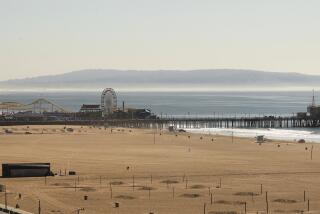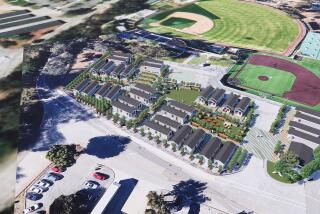Council Weighs Parking Zone for Neighbors of Santa Monica College
- Share via
The Santa Monica City Council will consider granting preferential parking to residents near Santa Monica College after a six-year dispute over parking and traffic congestion in the neighborhood.
College neighbors have sought preferential parking as a solution to chronic traffic and parking problems that have created what one community leader called “a neighborhood under siege by speeding college students.”
Preferential parking is being requested on weekdays between 8 a.m. and 8 p.m. in an area roughly bounded by 14th Street, Delaware Avenue, 20th Street, Pico Boulevard, 23rd Street and Ocean Park Boulevard.
The college has opposed preferential parking, saying it would inconvenience its largely commuter-student enrollment and citing the high costs of building on-campus parking structures and using shuttle systems.
Not the Solution
College President Richard Moore said he sympathized with the frustration of residents, but the “emotionally sensitive topic” of preferential parking is not the solution to an areawide traffic problem.
“Ours is only one element of the massive traffic and parking problem . . . on the Westside,” he said.
Trustee James Bambrick, an attorney, called the preferential parking proposal “the absolute height of folly” and questioned its legality.
“Banning non-resident parking may solve the problem for residents, but poses a very significant problem for people who want to go to the college,” he said. “The city has got to weigh the impact (preferential parking) will have . . . and I think any court would weigh the equities.”
Should preferential parking be granted, Bambrick said he will advise the college’s board of trustees to obtain legal counsel to “protect the rights of the broader community to have access to the college.”
Complaints on Congestion
Neighborhood groups such as the Santa Monica Safe Streets Committee have complained about traffic congestion in the area.
Sunset Park resident Duke Kelso said residents have suggested that the college expand ride-sharing programs for students and staff, establish shuttle systems and stagger peak class hours.
Kelso said a petition asking for preferential parking contained nearly 900 signatures.
Preferential parking, Kelso said, would send a message to the college: “The party is over. The use of our neighborhood for free, unlimited parking is over.”
Linda Sue Vaughan, who lives on 17th and Maple streets and witnessed a fatal accident involving two students last September, said she has no objections to paying a $15-per-car fee if preferential parking is implemented.
‘Always Been a Raceway’
“It has always been a raceway out there,” the part-time Santa Monica College student and mother of four said. “But (when) you have children and see people die, that’s when you say: ‘This has got to stop.’ I hate the fact that I’ll have to pay to park in front of my house, but it’ll save lives and doctor bills.”
Santa Monica City Manager John Jalili said a city study on the impact of preferential parking, completed last week, found that in the area where preferential parking is being proposed, student cars used 790 of 1,440 parking spaces in front of private homes during peak class hours. There are a total of 1,760 spaces in the proposed preferential parking zone, according to the study.
The college board of trustees last month approved the construction of a multilevel parking facility on campus, to be located at 1900 Pico Blvd.
Moore estimates that it will take two to three years and cost $2 million to $4 million to complete the structure.
Trustees also approved shuttle parking on one of the Colorado Place properties owned by the Southmark Pacific Corp.
Moore said the board approved emergency parking on two athletic fields on the 40-acre campus as a contingency plan in anticipation of preferential parking for neighbors.
Despite these efforts and the expansion of ride-share lots--there are 450 parking spaces on campus exclusively for ride-share students--Moore said he “still has to figure out how to get about 1,000 cars off the streets.”
More to Read
Sign up for Essential California
The most important California stories and recommendations in your inbox every morning.
You may occasionally receive promotional content from the Los Angeles Times.










